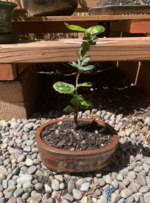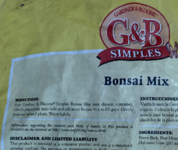I have been using G and B bonsai soil for about a year now, and mixed in some pumice and other coarse lava rock (not that much though) it has been successful for all of my trees(some conifers, coleonemas and boxwoods), but i am considering if i should replace the soil on all my bonsai with the usual ackadama pumice and lava rock mix, even on the newly potted saplings which i just potted a month ago. I put an example of what the soil looks like on one of my trees, it is a coastal live oak. The reason i am considering it is becuase i am weary of root rot, and I was wondering if i should replace the soil now before spring ends, or should i even replace it at all, because i do not want to mess with the process of the saplings getting established in the pot. Right now in my part of CA it is super hot, and i think having some soil moisture is okay currently, because it's currently 90 degrees.
You are using an out of date browser. It may not display this or other websites correctly.
You should upgrade or use an alternative browser.
You should upgrade or use an alternative browser.
Should I replace soil with corse mix now or next spring?
- Thread starter GrahamP7
- Start date
If you're talking soil, I suggest taking a look at this: bonsainut.com/resources/introductory-soil-physics.29
There's a yellow "download" button on the right-hand side of the page.
I can't read all the ingredients on the bag of G&B, but I see Forest Bark and Peat Moss. Those are going to be very water retentive, so you are not going to need to water as often. I know tree nurseries often use a bark-heavy substrate, but they also use larger containers and maybe water once a week.
From what I understand, many different substrates will work, but you have to care for each differently. Inorganic substrates with large particles are going to need more water more often because it holds less.
If I owned that tree in your photograph, I would go ahead and repot it, but in a much larger container so it had space to grow and thicken.
Think, what are your goals for the tree. Then figure out what techniques you need to apply to attain them.
I'm very new, so take all of this with a grain of salt.
There's a yellow "download" button on the right-hand side of the page.
I can't read all the ingredients on the bag of G&B, but I see Forest Bark and Peat Moss. Those are going to be very water retentive, so you are not going to need to water as often. I know tree nurseries often use a bark-heavy substrate, but they also use larger containers and maybe water once a week.
From what I understand, many different substrates will work, but you have to care for each differently. Inorganic substrates with large particles are going to need more water more often because it holds less.
If I owned that tree in your photograph, I would go ahead and repot it, but in a much larger container so it had space to grow and thicken.
Think, what are your goals for the tree. Then figure out what techniques you need to apply to attain them.
I'm very new, so take all of this with a grain of salt.
Mikecheck123
Omono
I'd wait. Little coast live oaks like that hate big root disturbances. This one might already be a goner, to be honest. Another repot would just be shooting it in the head.
Thats what i was thinking, and i actually only got him last week, and he was a bit neglected in the nursery but I think he will make it.I'd wait. Little coast live oaks like that hate big root disturbances. This one might already be a goner, to be honest. Another repot would just be shooting it in the head.
sorce
Nonsense Rascal
Really?Root rot is a myth!
Welcome to Crazy!
Sorce
lolReally?
Mikecheck123
Omono
Take everything @sorce says with a grain of hard grain alcohol.Really?
sorce
Nonsense Rascal
Really?
It's not as prevalent as we think and easily controllable.
I'd probably tack on an especially for bonsai, and another for California.
I've only found it in one ficus sitting in four inches of water in a styropot full of potting soil.
Overwatering is a myth too!
Seriously though.....
You'll never have a dead tree the day after overwatering.
Too dry for a day can kill em quick.
Sorce
Yeah, makes sense, what do you mean by tack on?It's not as prevalent as we think and easily controllable.
I'd probably tack on an especially for bonsai, and another for California.
I've only found it in one ficus sitting in four inches of water in a styropot full of potting soil.
Overwatering is a myth too!
Seriously though.....
You'll never have a dead tree the day after overwatering.
Too dry for a day can kill em quick.
Sorce
Wulfskaar
Omono
I've got a bunch of coast live oak seedlings, so I've been doing a bunch of research on them. The best time to repot is in winter when they go dormant. Think November through February, but wait until the weather has been cooler for a month or so. If November is hot like it was last year, then wait.
I've had zero luck on any that I collected so far, but I would think a pot-grown one would take the repot much easier during the dormant season.
I've had zero luck on any that I collected so far, but I would think a pot-grown one would take the repot much easier during the dormant season.
sorce
Nonsense Rascal
Yeah, makes sense, what do you mean by tack on?
Just "especially's".
One for Bonsai, one for Cali.
Sorce
Cadillactaste
Neagari Gal
What happened to traditional window of opportunity for repotting?
Patience apparently is something learned...
Landscape nurseries use organic medium for container plants with success. They wouldn't use it if they couldn't grow things. Let alone all my landscape thriving in very organic medium.
Patience apparently is something learned...
Landscape nurseries use organic medium for container plants with success. They wouldn't use it if they couldn't grow things. Let alone all my landscape thriving in very organic medium.
Gabler
Masterpiece
I’ve had roots that rotted, but I can’t say I’ve ever seen a tree die specifically from overwatering, and I live in a climate where cigars don’t need a humidor. Back when I did bonsai in middle school and high school, I used garden soil in my pots and watered every day. I still have two of my first trees. A pair of boxwoods from a garden center. One I planted in the ground right away and ignored for 14 years. The other was in a pot most of the time, but has been in the ground since I left home for college. They’ve weathered all kinds of abuse.
thanks!I've got a bunch of coast live oak seedlings, so I've been doing a bunch of research on them. The best time to repot is in winter when they go dormant. Think November through February, but wait until the weather has been cooler for a month or so. If November is hot like it was last year, then wait.
I've had zero luck on any that I collected so far, but I would think a pot-grown one would take the repot much easier during the dormant season.
yeah, for some reason i thought the repotting time for the live oak was spring but just learned its winter, I haven't done anything to my tree just wondering whats best for it going forward.What happened to traditional window of opportunity for repotting?
Patience apparently is something learned...
Landscape nurseries use organic medium for container plants with success. They wouldn't use it if they couldn't grow things. Let alone all my landscape thriving in very organic medium.
Cadillactaste
Neagari Gal
Always best to ask...before doing.yeah, for some reason i thought the repotting time for the live oak was spring but just learned its winter, I haven't done anything to my tree just wondering whats best for it going forward.
indeedAlways best to ask...before doing.
does thee little live oak seedling do beest in full sun?Always best to ask...before doing.
Wulfskaar
Omono
From my research... partial shade is good for the first few years of life. I read a study (trying to find it) that indicated higher success rates in partial shade than in straight sun. I'll try to find that article for confirmation.does thee little live oak seedling do beest in full sun?
EDIT: Here the article I read. It's not a cut-and-dry answer for you. It suggests that there is more water and less herbivory in shade. I give my seedlings that I grew from acorns this year partial shade and they seem to be doing well.
Go to this section: "Seedling establishment/growth:"
Because of drought and herbivory's deleterious effects on seedling survival, recruitment is best among germinants growing in shade, where herbivory protection and water availability are higher [157]. Recruitment among rock outcrops is relatively common as this offers some protection from large browsers [66]. Common nurse plants are California heathgoldenrod (Ericameria ericoides), chamise, coyote bush (Baccharis pilularis), purple sage (Salvia leucophylla), orange bush monkeyflower (Diplacus aurantiacus ssp. aurantiacus), chamisso bush lupine (Lupinus chamissonis), California sagebrush (Artemisia californica) and poison-oak (Toxicodendron diversilobum) [28,118]. Eighty percent of seedlings found on sites in the Santa Ynez Valley of Santa Barbara County were growing under purple sage or California sagebrush. Another 15% grew under mature coast live oak. Mortality due to herbivory was considerably higher among seedlings under parent trees [28]. Establishment is generally greater in coastal sage scrub than in other types of chaparral [30]. A study of coast live oak seedling establishment, with and without nurse shrubs and cages for protection, found that acorns planted in the open had higher germination but lower 1-year survival. Between 1 and 2 years of age, nurse shrubs had no effect on seedling survival, but cages continued to have a positive effect by reducing black-tailed deer browsing [118]. Another study of coast live oak establishment at 2 sites in central California showed strong association of seedlings with shrubs. Shrub cover was 30%, but 80% of coast live oak seedlings were under canopies. In 2 years of monitored growth, survivorship was 0% in open areas and 31% under shrubs. Seedlings in the open were grazed more, but drought also increased stress. Mortality related to moisture and temperature stress was 17% under shrubs and 63% in the open. The authors noted that differential dispersal might also increase recruitment under shrubs [28].
Last edited:
Similar threads
- Replies
- 8
- Views
- 165
- Replies
- 1
- Views
- 103


